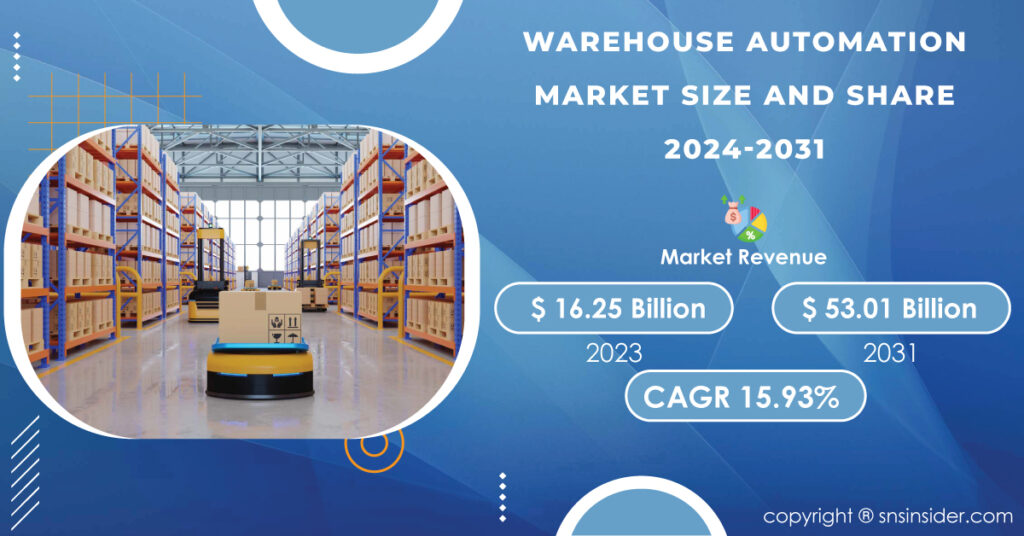
The Warehouse Automation Market, valued at USD 16.25 billion in 2023, is projected to surge to USD 53.01 billion by 2031, growing at a robust CAGR of 15.93% from 2024 to 2031.
This growth is driven primarily by the increasing demand for faster order processing and more efficient distribution systems in the e-commerce and retail sectors, where automation significantly reduces labor costs and improves accuracy. Technological advancements in robotics, artificial intelligence, and machine learning further enhance the capabilities of warehouse automation systems, making them more adaptable and efficient. Additionally, the ongoing shift towards Industry 4.0, with its emphasis on interconnectivity and smart automation, is accelerating the adoption of automated solutions across global supply chains, supporting scalability and operational efficiency.
Market Analysis
The Warehouse Automation Market has witnessed robust growth over the past decade. Factors fueling this growth include the rise in e-commerce, increasing consumer expectations for faster delivery, labor cost savings, and advancements in robotics and digital technology. According to recent studies, the warehouse automation market is expected to grow from USD 16.25 billion in 2023 to over USD 53.01 billion by 2031, at a compound annual growth rate (CAGR) of approximately 15.93%. This growth is driven by the increasing adoption of various automation solutions including robotics, conveyor belts, automated sorting systems, and software management systems.
Download Free Sample Report of Warehouse Automation Market @ https://www.snsinsider.com/sample-request/4211
Top Companies Featured in Warehouse Automation Market Report:
- Jizhong Energy Storage
- Viastore Systems
- Kardex Remstar
- Interroll
- Honeywell Intelligrated
- Aeologic Technologies
- Kiva Systems
- Grey Orange
- Swisslog
- Geek+
Recent Developments in the Warehouse Automation Market
- Robotics Integration: There has been a significant surge in the integration of robotics into warehouse operations. Companies like Amazon and Alibaba have deployed thousands of robots for inventory management and goods transportation within their facilities.
- AI and Machine Learning: Advanced algorithms are being utilized to predict inventory levels, optimize robot paths, and manage resources effectively. Machine learning models are also being developed to improve the picking accuracy and speed of robotic systems.
- IoT and Connectivity: Enhanced connectivity through the Internet of Things (IoT) enables real-time data collection and insights, improving decision-making processes and operational efficiency in warehouses.
- Green Automation: Eco-friendly automation solutions are gaining traction, focusing on reducing the carbon footprint of warehouse operations through energy-efficient systems and sustainable practices.
Segment Analysis
The Warehouse Automation Market can be segmented by component (hardware, software, and services), technology (AS/RS, conveyor, robotics, WMS), and application (e-commerce, automotive, food & beverage, retail). The robotics segment is experiencing the fastest growth due to the reduction in robotics costs and the high efficiency provided by robotic systems. The e-commerce sector remains the largest consumer of warehouse automation due to the massive volume of products handled and the need for rapid fulfillment.
Warehouse Automation Industry Segmentation as Follows:
By Type:
- Warehouse System
- Mechanized Warehouse
- Advanced Warehouse
- Basic Warehouse
By Component:
- Software
- Hardware
By Technology:
- Retrieval Systems & Automated Storage
- Automatic Guided Vehicles
- Autonomous Mobile Robots
- Voice Picking & Tasking
- Automated Sortation Systems
By Application:
- Apparel
- Food & beverage
- Pharmaceutical
- Automotive
- E-Commerce
- Grocery
Ask Your Query Before Buying this Research Report @ https://www.snsinsider.com/enquiry/4211
Impact of Global Events
The COVID-19 pandemic has had a profound impact on the Warehouse Automation Market. With the surge in online shopping due to lockdowns, companies faced unprecedented demand and pressure to deliver efficiently. This led to increased investments in automation to handle volume spikes, maintain social distancing norms, and reduce human contact.
Key Regional Developments
- North America: Dominates the market with advanced technological adoption and the presence of major e-commerce players.
- Europe: High adoption rates due to stringent labor laws and an increase in robot-assisted systems.
- Asia-Pacific: Fastest growing region, driven by rapid industrialization, rising e-commerce platforms, and investments in automation technologies.

Key Takeaways from Warehouse Automation Market Reports
- Scalability and Flexibility: Businesses are looking for scalable and flexible automation solutions that can adapt to changing market conditions and business growth.
- ROI and Cost-Effectiveness: Companies are focused on solutions that offer quick returns on investment and long-term cost savings.
- Integration with Legacy Systems: Seamless integration with existing warehouse management systems remains a priority for businesses to ensure continuity and minimize disruptions.
Conclusion
The Warehouse Automation Market is set to continue its rapid growth trajectory, fueled by technological advancements and shifting industry paradigms. As businesses around the world adapt to the new normal post-pandemic, the demand for efficient, reliable, and innovative warehouse solutions is expected to soar, driving further innovations and investments in this sector. Companies looking to stay competitive in this evolving market landscape will need to embrace these technologies, ensuring they are well-positioned to meet the demands of the future.
Table of Content – Major Key Points
1. Introduction
2. Research Methodology
3. Market Dynamics
4. Impact Analysis
5. Value Chain Analysis
6. Porter’s 5 forces model
7. PEST Analysis
8. Warehouse Automation Market Segmentation, By Type
9. Warehouse Automation Market Segmentation, By Components
10. Warehouse Automation Market Segmentation, By Technology
11. Warehouse Automation Market Segmentation, By Application
12. Regional Analysis
13. Company Profile
14. Competitive Landscape
15. USE Cases and Best Practices
16. Conclusion
Continued….
Access Detailed Research Insight with Full TOC and Graphs @ https://www.snsinsider.com/reports/warehouse-automation-market-4211
About Us:
SNS Insider has been a leader in data and analytics globally with its authentic consumer and market insights. The trust of our clients and business partners has always been at the center of who we are as a company. We are a business that leads the industry in innovation, and to support the success of our clients, our highly skilled engineers, consultants, and data scientists have consistently pushed the limits of the industry with innovative methodology and measuring technologies.
Contact Us:
Akash Anand – Head of Business Development & Strategy
Phone: +1-415-230-0044 (US)
Information contained on this page is provided by an independent third-party content provider. Binary News Network and this Site make no warranties or representations in connection therewith. If you are affiliated with this page and would like it removed please contact [email protected]



Comments